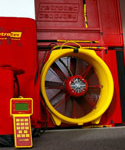Air Duct Testing

Professional energy auditors use blower door tests to help determine a home's airtightness.
Importance of Building Airtightness
These are some reasons for establishing the proper building tightness:
- Reducing energy consumption due to air leakage
- Avoiding moisture condensation problems
- Avoiding uncomfortable drafts caused by cold air leaking in from the outdoors
- Making sure that the home's air quality is not too contaminated by indoor air pollution.
How Air Duct Tests Work
A blower door is a powerful fan that mounts into the frame of an exterior door. The fan pulls air out of the house, lowering the air pressure inside. The higher outside air pressure then flows in through all unsealed cracks and openings. The auditors may use a smoke pencil to detect air leaks. These tests determine the air infiltration rate of a building.
Blower doors consist of a frame and flexible panel that fit in a doorway, a variable-speed fan, a pressure gauge to measure the pressure differences inside and outside the home, and an airflow manometer and hoses for measuring airflow.
There are two types of blower doors: calibrated and uncalibrated. It is important that auditors use a calibrated door. This type of blower door has several gauges that measure the amount of air pulled out of the house by the fan. Uncalibrated blower doors can only locate leaks in homes. They provide no method for determining the overall tightness of a building. The calibrated blower door's data allow the auditor to quantify the amount of air leakage and the effectiveness of any air-sealing job.
Preparing for an Air Duct Test
Take the following steps to prepare your home for a blower door test:
- Close windows and open interior doors
- Turn down the thermostats on heaters and water heaters
- Cover ashes in wood stoves and fireplaces with damp newspapers
- Shut fireplace dampers, fireplace doors, and wood stove air intakes.




